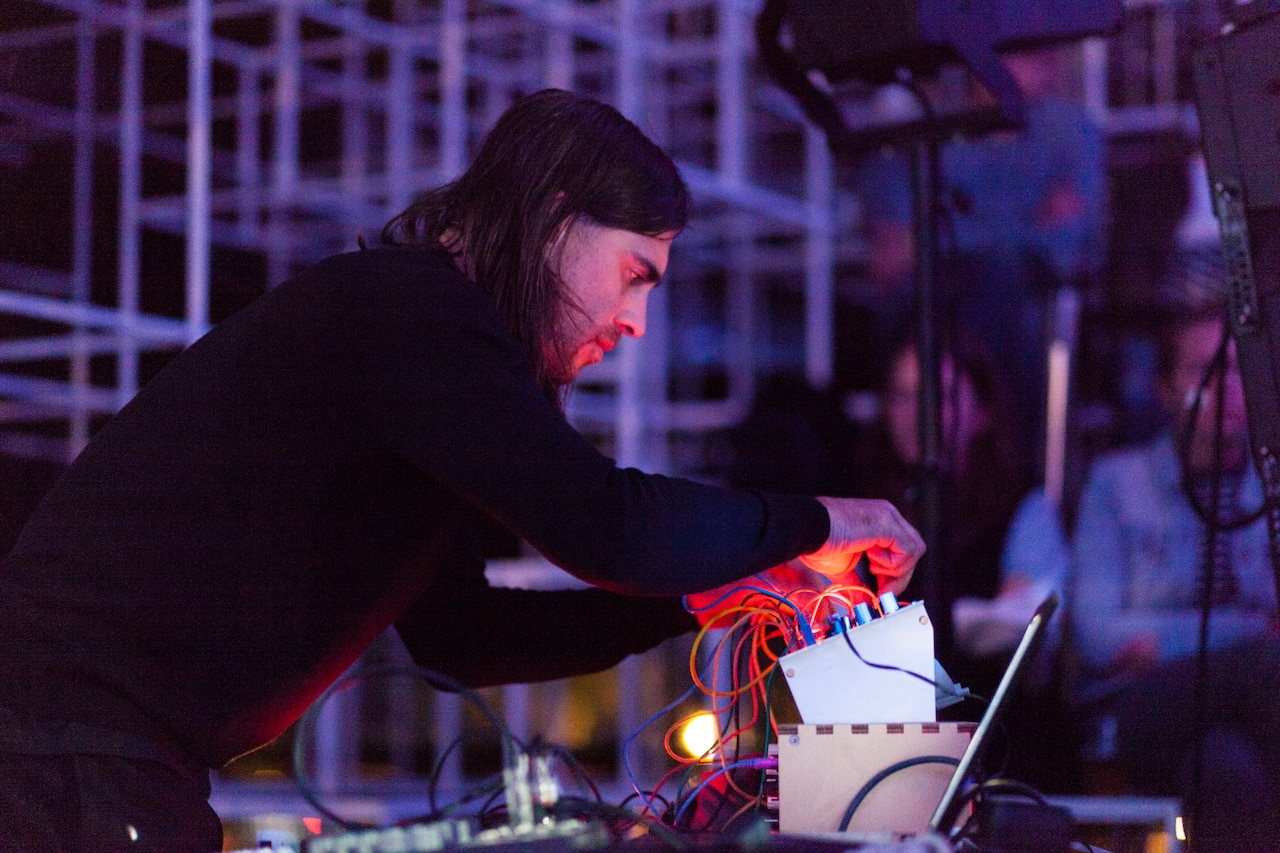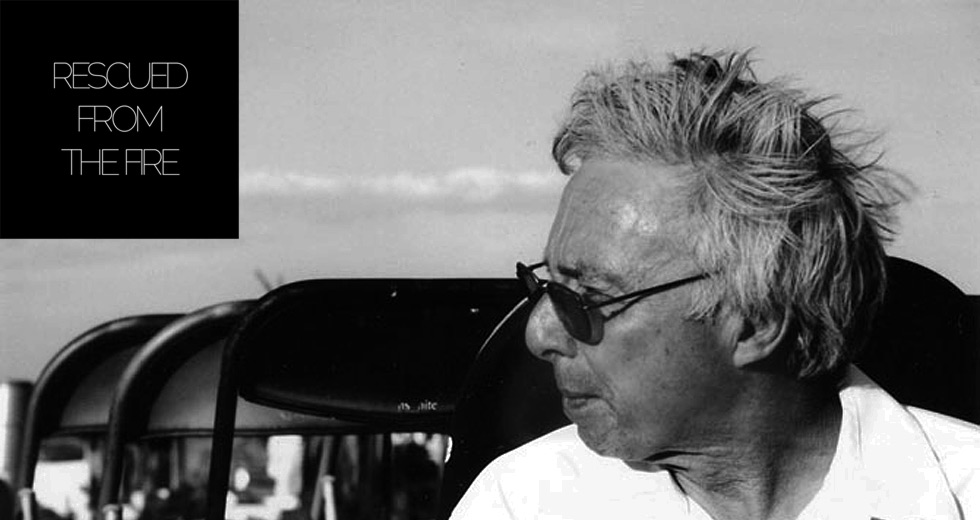Noise Artist Russell Haswell Breaks Down his Many Projects

As a curator and multi-disciplinary artist, it was only after delving into sound that Russell Haswell really found his voice: chaotic, unravelling noise that can be compellingly rich, shockingly fierce, and comprehensively abstract all at once. His many releases on Editions Mego are designed to confound, posing questions of aesthetics, improvisation and industry, while offering no straightforward answers.
In fact, a healthy sense of collision is what the longtime friend and collaborator of Aphex Twin strives for – in an interview, Haswell imagined a perfect night of music to be “Derek Bailey, then Carcass, then Jeff Mills,” so it’s no surprise then that he was asked to curate events in London for All Tomorrow’s Parties. It also goes some way to describe his own music: part noise, part techno and part free improvisation rolled into a surprising and immersive whole.
In this excerpt from his recent interview with RBMA Radio’s Hanna Bächer, Haswell talks about his creative process and many projects over the past two decades.
Going Solo
I’ve worked as an artist’s assistant, but I only had a certain period of time that I could manage working for other people. When you’re making work for other artists, all you think about is how you ought to be making some work yourself, and it becomes quite frustrating. As a consequence, I became a curator programming events inside museums, music events or club events. In the end, I became disillusioned with supporting artists that I didn’t like, because you had to assist and generally present other artists. If they’re not people that you admire, it’s really hard.
Your laptop would often crash during a gig. Really, everything was in the hands of the gods rather than my own.
After all those different experiences, I decided that I had to concentrate on my own work. I shifted away from visual things and started to work with sound, probably because I had a laptop for the first time in my life and I had some editing and processing tools – and some early plugins. Prior to that, my entire experience with sound and sound design was using other people’s equipment. I was experienced in it professionally, but I couldn’t do these things myself, in my own space.
Live Salvage
The gigs that were documented on the first Live Salvage were done using other people’s laptops. It was all on borrowed equipment and it all had to be improvised. It had to be worked out on the day. That record came together because some of the events that I played at had been documented, in some cases quite crudely on video or cassette. Back then, laptops weren’t really what they are now. They’d crash all the time. There wasn’t much DSP. There weren’t many plugins, and they were CPU-intensive. Your laptop would often crash during a gig. Really, everything was in the hands of the gods rather than my own.
Live Shows
After putting sound into galleries – whether it was either my own or for other artists – I realised what was more interesting and exciting was to be at a festival or a gig with an audience. And to be with an audience that only experiences your thing for a short period of time. It’s more like a happening. There’s an intensity that’s created because it’s got a short duration compared to an exhibition. Maybe it’s an hour long. Maybe it’s ten minutes.
I’ve done some incredibly short concerts, some of which were purely because people stopped me, or because my computer crashed, or because I actually didn’t realise that I’d only played ten minutes. It felt like an hour, so there’s a kind of time distortion. Sometimes I would say they were inspired by trips to Japan when I’d seen artists like Masonna, who famously does very short gigs. I was involved in bringing Masonna to Europe for the first time for the John Peel Meltdown at the Southbank Centre, where he played for ten minutes.
Nowadays I’m asked to play much longer periods. I remember playing for an hour at the Berlin Atonal festival two years ago, and that just felt like eternity. I had my iPhone with the timer and I was like, “Jesus, I’ve still got 45 minutes to go. It already feels like an hour.” I would say it’s easier to play for longer now. But that’s possibly because I have more equipment and more options.
Satanstornade
Satanstornade was originally called Satan’s Tornado, but Masami spelled it wrong, so I left it. It was all improvised, recorded in the same amount of time that it appears. We recorded it in London, in a friend’s house. My friend happened to have one of these four track recorders that had a minidisc, and it enabled us to send two stereo feeds into this thing and mix it to stereo direct.
I hadn’t seen the guys from Warp for some time at that point. I went to visit them, and played it to Steve Beckett and he was into it. I guess it was different to anything else that they’d ever released, so we put it out and gave it an interesting catalog number. 666. People still talk about that record.
Pain Jerk
I met Pain Jerk the first time I went to Japan, but we kind of lost touch. I went to Japan many more times and he wasn’t around or nobody knew where he was. I’d lost his email. He didn’t have a mobile phone, didn’t have a landline telephone. Just a few years ago, I found a DAT tape that Pain Jerk had given me. I thought, “Wow, this is great, this is ten years old. This hasn’t been released. This is lost in time. Maybe we should release this somehow.”
I managed to get hold of Pain Jerk’s email. He seemed to have a new one or he’d reappeared. I sent it to him and just said, “Hey, should we do something with this DAT tape of yours that I just found.” He didn’t want to, but it was really great to be in touch. Then he came to Europe to do a tour and we started to discuss the idea of doing a collaboration. I started offering him some material, and then asked him to work with that. Then he sent me some material of his and I worked with that. We started to compile it. We started to process it. At one point we had about five hours of material, so, in the end, we decided to make it a double CD. I compiled one disc and he compiled the other one.

Scandinavian Parts
Scandinavian Parts was a record that was on this Swedish label iDEAL. I’d been asked by Joachim Nordwall who does that label to make an album. Just prior to that I had been on tour with Autechre all around Europe, including Scandinavia. I recorded the tour in its entirety, apart from a few gigs where the recordings didn’t work.
I had a four channel recorder so I could record in a crude 360 degree format. It wasn’t Ambisonic, but it was four channel, let’s say quadraphonic recording. I realised that I could use some software to decode this down into two channels. It was a format from the ’70s called UHJ, which was an Ambisonic format and meant that you can actually have a stereo vinyl, and if you have the right decoder you can decode a stereo recording into multichannel surround.
There’s only really one decoder in the world that still exists, made by a hi-fi manufacturer called Meridian. It’s very audiophile high-end expensive equipment, so I don’t have one. I worked with Rashad Becker and a friend of mine Tony Myatt, who at the time was from York University Music Research Center. We made an encoder and decoder for UHJ.
I had to work pretty hard with Rashad Becker to actually cut this stereo-to-multichannel decodable format, UHJ to vinyl, because although it’s something they did in the ’70s, it plays around with the phase quite a bit. It’s within the phase information that the surround decodable data is retrieved. That inhibits the way that you cut a vinyl normally.
It was a fairly complex thing. I had to go to some audio engineering society conventions and meet some of these older professor engineer type guys that had worked with this format in the ’70s. I managed to get some information from them that I could forward to Rashad. It wasn’t so straightforward. It wasn’t like I just downloaded some plugin and it worked. I also had to get my material approved by Dolby for the Mego DVD. They said it was one of the maddest things that they’d ever approved.
When I knocked on his door, I expected him to walk out with an EMS synth. I was praying that he must have a little pile of them left and surely would give me one for giving him this wonderful, generous commission.
TBA21 + EMS
I was a short term curator for TBA21. One project was called “The Morning Line,” which was a pavilion built as a collaboration between an artist and some architects. It had five surround sound zones which had all been programmed by Tony Myatt and some of his PhD students. An audience member could walk through this pavilion, through these spherical surround sound zones.
Various artists were commissioned to make sound works for the pavilion. I was involved in the project as a curator. Peter Zinovieff was somebody that I’d never met at the time, but I was familiar with his work. I was familiar with the history of EMS. I’m also a bit of a film buff. One of my favorite films is a Sidney Lumet movie from the early ’70s called The Offence, which stars Sean Connery. Although the soundtrack is credited to Harrison Birtwistle, in the final credits of the movie it had a credit for “electronic realisation by Peter Zinovieff for EMS studios.” Most of the material within that soundtrack has some electronic process, some electronic effect, or has synthetic sound. So Peter Zinovieff was in my mind for many years.
When I knocked on his door, I expected him to walk out with an EMS synth. I was praying that he must have a little pile of them left and surely would give me one for giving him this wonderful, generous commission. He didn’t have anything like that. He didn’t even have any speakers at the time. Maybe he did, he had some little tabletop nonsense, but when we gave him the commission it really was a situation of, “Look Pete, you’ve got to sort it out, you need to get something.” Obviously these things have all changed now. He’s now working often. He seems to do more than I do. I’m jealous.
I said, “I don’t make records with beats. But if you get me a bass drum and a snare, I’ll do it.”
Hecker
The collaboration with Florian Hecker was really all about our mutual interest in Iannis Xenakis’ computer work. Blackest Ever Black was done using the UPIC computer system. In essence, you can draw the sound. This gave us ideas of synesthesia and that you could see sound. In the instance of Blackest Ever Black, we drew and copied pictures. Xenakis used things like shell formations and natural geometry and then listened to the results and either incorporated them into a composition or didn’t. In a way, that’s exactly what we did.
The other project we did was using the GENDYN system, which is a Generative Dynamics Stochastic synthesis computer method. It’s where you control random elements that are determining the frequency and the wave shape, and these things are evolving over a period of time. We worked with a programmer called Alberto DiCampo who had implemented the GENDYN software in SuperCollider.
We also had an opportunity in Munich to do a four wall projection of Kanal, which is a film of the Zurich sewage system by a kind of droid that checks to see if it’s leaking or broken or whatever. We thought that GENDYN would be great for this journey of this film. We did a concert with the video in surround quadraphonic with four screens, and the recording of that presentation became the record. The record was interesting because it was over an hour long on a single vinyl.
Diagonal Records
I don’t know how [Diagonal label founder] Powell came across anything that I’d ever made, but I was walking down the road in Shoreditch and this big tall young guy was waving at me on the street. I had my headphones in and I just thought, “Who’s this guy? What’s going on here?” I kind of ignored him and walked past him on the street.
Anyway, later the very same evening in Café OTO, Mika Vainio and some other people were playing. By chance Oscar Powell was there at that gig. He immediately came up to me, “Yeah, yeah, you’re Russell. I want you to make a record for my label.” I was asking him, “Well, why do you want me to make a record? I’m not sure why you’ve decided that you’d like me on your label.” He said, “But I want you to make a record with a beat.” I said, “I don’t make records with beats. But if you get me a bass drum and a snare, I’ll do it.”
He got me a module, so I incorporated them into my modular synths. It was a relatively new thing to have these drum modules at the time, rather than having to use seven oscillators to make a bloody hand clap or something. I set about making this record, 37 Minute Workout. I made it quite quickly and we released it quite quickly. It came out and was kind of well-received, I guess, for my kind of work.
Since that record, I DJed in Tresor for the first time in my life. But I’ve been going to Tresor since 1996 or something. Or earlier than that. I’ve known the records since they first started. It’s something that is in my vocabulary of music. I think techno is quite significant. It’s really one of the most significant dance genres, far more significant than the things that have come since.

